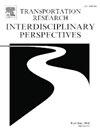Unequal relational travel patterns of long-distance rail trips between different levels of settlement hierarchies – Case study from Hungary
IF 3.9
Q2 TRANSPORTATION
Transportation Research Interdisciplinary Perspectives
Pub Date : 2025-03-19
DOI:10.1016/j.trip.2025.101387
引用次数: 0
Abstract
The study of long-distance travel behaviour has become a prominent field of research on a global scale. Parallel with economic development, the proportion of long-distance trips undertaken by individuals and groups across the globe is increasing. Based on a countrywide on-board passenger survey conducted among passenger rail users in one of the highest railway modal-share member states of the European Union, Hungary, significant differences have been revealed by novel interdisciplinary statistical methods. Passengers were voluntarily asked about their actual trip characteristics and their basic socio-economic background. Origin and Destination (OD) trip settlements were classified into specific settlement hierarchy groups and by the novel Sum of Ranking Differences (SRD) algorithm and ANOVA, the multiple surveyed socio-economic trip characteristics were grouped.
The results confirm that a higher level of settlement network hierarchies generates overall more though not necessarily more frequent long-distance trips, which are not equal to all sub-categories. The analysed three most frequent travel purposes (work, education, other) show significant variation between the different OD pairs. Long-distance work and education trips are more homogeneous in comparison with leisure and visiting friends and relatives’ trips. In all trip purpose categories, lower settlement hierarchy level connections demonstrated different travel patterns. The challenging socio-economic conditions in rural areas require improved travel conditions that are spatially and socially balanced. When deciding about costly timetable-oriented infrastructure developments, policy makers and transport organisers must consider all kinds of needs. The revealed unequal OD trip patterns call for policy recommendations for the respective spatial and transport planning authorities.
求助全文
约1分钟内获得全文
求助全文
来源期刊

Transportation Research Interdisciplinary Perspectives
Engineering-Automotive Engineering
CiteScore
12.90
自引率
0.00%
发文量
185
审稿时长
22 weeks
 求助内容:
求助内容: 应助结果提醒方式:
应助结果提醒方式:


